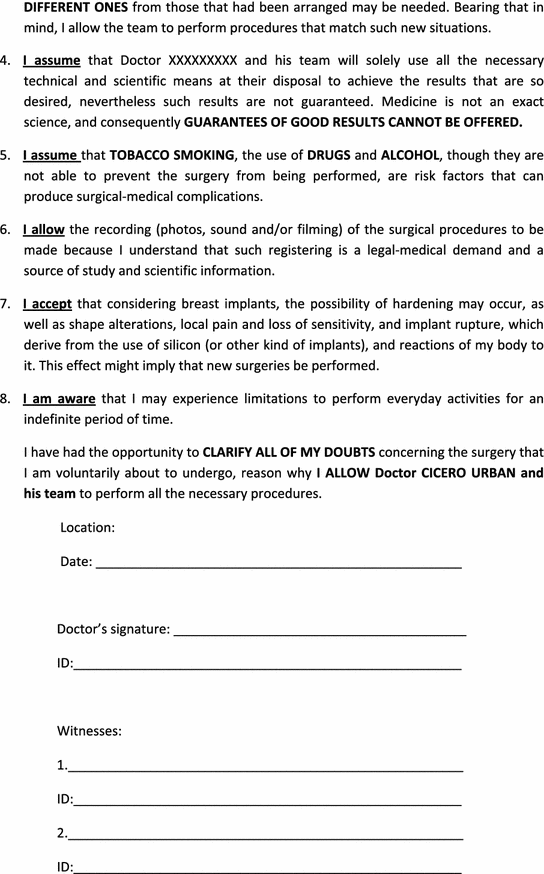
Fig. 49.1
Informed consent model for oncoplastic and reconstructive surgery from the Breast Unit of Hospital Nossa Senhora das Graças, Curitiba, Brazil
Death
Myocardial infarction
Stroke
Deep venous thrombosis
Pneumonia
Infection
Bleeding
Prolonged drainage
Partial or total necrosis of skin or flaps
Seroma
Hematoma
Multiple surgical procedures/reoperation
Loss of implant or expander
Nonsymmetry of breasts
Expectations not met
Recurrence of cancer
Prolonged care/wound care
Necrosis of nipple–areola complex
Loss of sensation of nipple–areola complex
Chronic pain
Keloids/scars
Discoloration
Need for drainage/aspiration
Lymphedema
Pain, swelling, numbness, disability, dysfunction of arms
Nerve or blood vessel damage
Hernia
Pneumothorax
Fat necrosis
Implant contracture, immediate or delayed
Rejection of implant at any time
Rupture of expander or implant.
A good informed consent process will not only protect the surgeon but will also enhance the relationship with the patient.
49.7.4 Documentation
Documentation is the cornerstone of any malpractice defense. Good documentation may convince a plaintiff’s attorney not to pursue a case. In addition, it is certainly valuable when reviewing a patient’s care and outcomes as well as making treatment plans. Documentation includes many aspects of the medical record. The hospital medical record should be completed in a timely manner, including the history, physical examination results, consents, operation notes, and discharge summary. The office records should include all interactions and contact with the patient, such as telephone calls, literature given to the patient, notes of office visits, consents, correspondence, and photographs (preoperative and postoperative). The office notes should include the history, physical examination results, diagnostic results, diagnosis, treatment plans, referrals, alternatives, risks, and the patient’s desires and expectations. Of course, no record should be altered after being signed off as this greatly weakens the credibility of the medical record. Late entries are allowed if they are indentified as such. The records should also be legible.
49.7.5 Event Management
Despite the surgeon’s best efforts, poor outcomes do occur. Patients and their families are often very disappointed with these results. They have trusted the surgeon to meet their expectations and when that does not occur, trust is shaken and the surgeon is likely to be second-guessed. It is at this point that the relationship with the patient may be lost. The surgeon must continue to communicate. It is necessary to give a full and honest explanation to the patient and the patient’s family. Sincere and empathic apologies may also help to ease the disappointment. In this regard, many lawsuits are filed simply because of lack of explanation [37]. These patients and their families may not have been personally approached by their surgeon or may feel something may be being “covered up”. Many plaintiffs file complaints to find out the truth.
In addition, some progressive malpractice insurers wish to be notified of adverse events when they happen to help guide the surgeon in recovering the patient’s trust. This interaction is important as the surgeon and his or her ego are most vulnerable at this time. The initial impulse is to avoid the situation, and that is precisely the wrong approach [38–40]. Advice from an event manager can prove to be quite helpful in avoiding litigation. Many feel that this transparency is full of potential problems but, in fact, this approach can actually decrease the frequency of lawsuits, increase credibility, and maintain the physician–patient relationship.
49.8 Conclusions and Perspectives
Bioethics has been walking together with the development of biotechnology and with its dilemmas, which go far beyond the technical–scientific debate. Within reconstructive breast cancer surgery specifically, there is the need for introducing bioethics and medicolegal aspects into the educational programs for specialists. It is true that technological development has improved the possibilities for the diagnosis and treatment of breast cancer, but the individual experience of those who deal with this malady daily is not the only object of scientific calculation. In addition to scientific competence, physicians must have the humility to recognize their role and their limits: taking care above curing. This is the most important virtue to be cultivated by the breast surgeon with the aid of bioethics, reducing claims and improving the breast cancer patient’s survival and quality of life.
References
1.
Callahan D (2004) Bioethics. In: Post SG (ed) Encyclopedia of bioethics. Thomson & Gale, New York, pp 278–287
2.
Jonsen AR SM, Winslade WJ (2010) Clinical ethics, 7th edn. McGraw Hill, New York
4.
Emanuel EJ, Wendler D, Grady C (2000) What makes clinical research ethical? JAMA 283(20):2701–2711
5.
Emanuel EJ, Currie XE, Herman A. Undue inducement in clinical research in developing countries: is it a worry? Lancet 366(9482):336–340
6.
Callahan D (1999) False hopes: overcoming the obstacles to a sustainable, affordable Medicine. Rutgers University Press, New Brunswick









